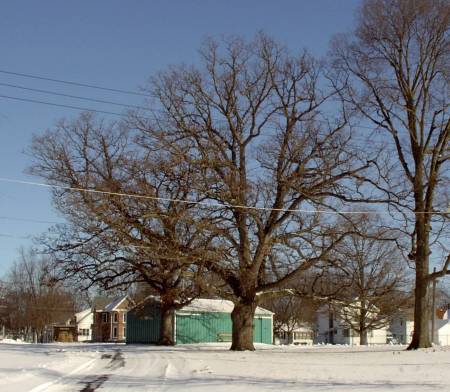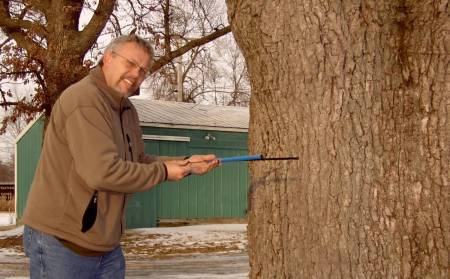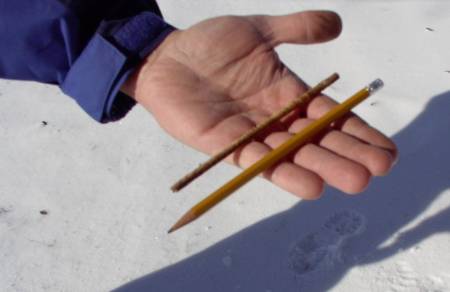
How old is this White Oak that resides at the Whiteside County Fairgrounds?

Randy Nyboer drills a hole in the thick bark with an increment bore.

The core extractor, a long, u-shaped gouge, is inserted into the hole. It slices into the tree's interior to create a cylinder of wood.

The core sample displays light and dark growth rings. They will help Nyboer date the tree.
|
Schoolchildren in 1907 designated the long-lived Native Oak as the State Tree of Illinois. Perhaps one reason was these imposing trees can live to be 300 to 600 years old. In 1973, a special poll of 900,000 schoolchildren changed the State Tree to the White Oak. There is a fine one growing at the Whiteside County Fairgrounds, as shown in the first photograph.
This tree inspired Randy Nyboer to design a sesquicentennial project. Because he thinks this oak may be at least 150 years old, he initiated a plan to date the tree. Colored rings visible on a core sample will indicate the tree’s age and growth rates. The rings are caused by moisture the tree receives during its growing season, between the frost dates of May 15 and October 15.
Nyboer is a Research Ecologist for the Illinois Natural History Survey. His position is an adjunct of the University of Illinois and the Illinois Department of Natural Resources. Previously, he was a Regional Biologist for the IDNR. During that time, he earned the nickname “Prairie Doc” because of his work healing prairies. This involved managing the land, prescribing controlled burns to force the release of seeds, and removing invasive species, like Buckthorn trees in prairies and Loosestrife in wetlands. His moniker is not to be confused with the yellow Prairie dock wildflower.
On January 23, 2005 Nyboer surveyed a large White Oak tree at the Fairgrounds. He noted a possible squirrel hole where a limb had been removed. He explained this was evidence that the tree had some center rot. There were also signs of past lightning strikes and wind damage. Still, he pronounced the tree “pretty solid.”
Next, he measured the distance around the immense tree at chest height with a unique, diameter tape measure. It converted the circumference of 155.68 inches into the tree’s diameter of 52.75 inches. “For an oak, this is definitely good. Some of the lower, large-diameter branches are well over 100 years old.”
Nyboer stepped off the span of the tree’s branches, known as its drip pattern. This second diameter indicates how far the roots spread from the trunk to soak up rain. He estimated a distance of 103 feet.
Finally, he screwed an increment bore three inches into the tree. In the second photograph, he twists the bore, making a hole about one centimeter across. It created an odd creaking as it vibrated into the wood. The third photo shows a long, u-shaped gouge, called a core extractor, being inserted into this hole. The sample was slowly withdrawn. The wooden cylinder that emerged was ¼ of an inch in diameter and about seven inches in length, smaller than a pencil. “I had solid wood all the way through, about one foot deep,” observed Nyboer.
The last photograph shows the striped core sample from this giant White Oak. The “rays” are the white lines. They transport water across the wood to the outer, growing portion of the tree, which is directly under the bark. The brown “growth rings” act as a food elevator. They transport water and minerals from the roots up the tree to the branches and leaves. These rings return water and nutrients from leaves to the roots.
To age a tree, count the average number of rings per inch on the core sample. Ideally, the sample should be 10 to 12 inches long to obtain a more accurate measure of the tree’s growth over time. Older trees grow more slowly; thus, their rings at the outer layers are closer together. Multiply this average number times the radius (half the diameter) of the tree to find its approximate age.
The process works the same on any species of tree Nyboer commented. However, “an oak tree core sample may yield 10-12 growth rings per inch, while a fast-growing Cottonwood may have two or three.” These rings indicate the dryness or wetness of the climate in which the tree grows. The closer the rings are, the less moisture the tree received during the growing season. “White Oaks grow successfully, because they accept a wide range of water amounts.”
“It isn’t as old as some people may think it is,” he remarked. This specimen probably grew fast. That is because the oaks at the Whiteside County Fairground, as well as those in Morrison, were open-grown, as opposed to forest-grown. “On a savannah you find a mix of forest and prairie. Trees receive plenty of sunlight. Open-grown, spreading branches [of this tree] indicate this [area] was a savannah. Savannahs developed 2500 years ago in this part of Whiteside County,” he added.
“Ten to twenty thousand years ago, this area was all pines and spruce; climate changes altered that. Plants [Oaks] migrated one acorn at a time over a period of thousands of years. More trees are coming in now than 200 years ago, [because] we’ve gotten more water. [This] is a good environment for them.”
He continued, “There is always a tension zone between the prairie and the forest. [The boundary] was often determined by the frequency of natural fires, which stimulated prairie growth, but retarded forest growth. Thick barks on oaks are somewhat fire-resistant, thus, creating savannahs--a mix of prairie grasses and oaks.”
This spring, Randy Nyboer will research the age of Morrison trees and write a report in a scientific journal for the State of Illinois. For his data base, he will include only White, Burr, Black, and Red Oaks and hickories. The source of the samples will be the Fairgrounds and Grove Hill Cemetery, because these locations reflect “presettlement” areas of tree growth. These trees will create a base line of ages to help date trees in the community. He stated, “On a hill, you get a lot of variation in growth from north to south and top to bottom, due to differences in water, soil, and sunlight.”
In honor of Morrison’s sesquicentennial, Nyboer has volunteered to date vintage oak and hickory trees for local residents. However, trees must be at least two feet in diameter to be included in his research project. Those with a smaller diameter will be younger than 150 years in age. The process takes 10 to 15 minutes and does not harm the tree. He will take the sapless core sample home to dry, date, and record. With dry wood, “rings show up that much better” and give a more accurate ring count. The data collection will begin in late March, before sap starts running, and continue until mid-May, when the leaves appear.
After evaluating and recording the data, Nyboer will place the core in a clear drinking straw for the owner. The sample may be claimed at the Sesquicentennial Store at 218 W. Main. To have your oak or hickory tree dated, call Nyboer at 772-2714 to schedule an appointment. There is no charge.
The wildcatters drilled for oil,
‘49ers panned for gold
Randy Nyboer, Prairie Doc,
Bores oak trees in search of “old.”
Nyboer will disclose the age of this majestic White Oak on Sunday, July 10, during the sesquicentennial celebration at the Whiteside County Fairgrounds.
by Stephanie A. Vavra, Guest Columnist
January 31, 2005
|

